
The port shields of a Vor'cha-class take a hit from a photon torpedo
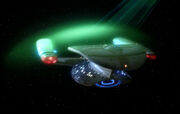
The deflector shields of a Galaxy-class starship's stardrive section

The forward shields of a D-12-class Klingon Bird-of-Prey take a blast of phaser fire from the USS Enterprise-D
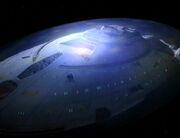
The deflector shields of an Intrepid-class starship's primary hull
Deflector status display of a Constitution-class starship
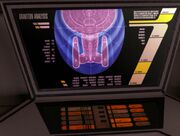
A graviton analysis of a Galaxy-class starship's shields
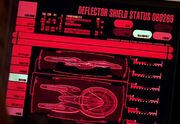
Deflector status display of a Sovereign-class starship
- You may also be looking for shield, the hand-held namesake.
Deflector shields or screens, generally referred to simply as shields, were a type of force field that surrounds a starship, space station, or planet to protect against enemy attacks or natural hazards.
Operation
Deflector shields operated by creating a layer, or layers, of energetic distortion containing a high concentration of gravitons around the object to be protected. On starships, the shield contained six sections, forward, starboard, port, aft, dorsal, and ventral. (Star Trek Nemesis) Shield energies could be emitted from a localized antenna or "dish", such as a ship's navigational deflector, or from a network of "grid" emitters laid out on the object's surface, such as a starship's hull. Since at least the 23rd century, deflector shields were essential equipment on starships.
Neither matter nor highly-concentrated energy could normally penetrate a shield. When shields were "up," or energized at a high level, most matter or energy that came into contact with the shields was harmlessly deflected away. This was important in starship combat, as shields were essential for hull protection. When the shields were up, only minor hull damage would be expected during combat. In the 23rd and 24th century, without deflector shields weapons were capable of causing catastrophic damage to starship hulls almost immediately. (Star Trek II: The Wrath of Khan; Star Trek VI: The Undiscovered Country; Star Trek Generations)
Continuous or extremely powerful energy discharges could progressively dissipate the integrity of a shield to the point of failure. Shield capacities varied according to many variables, from the power available to environmental concerns, making definitive and universal calculations of how much damage they could take difficult to estimate. Therefore, during combat tactical officers would continually report on shield strength, usually as a percentage of total effectiveness, with 100% meaning that the shields were at full capacity, and lower percentage scores indicating weaker shield conditions. Specific sections of the shield grid could take more damage than other sections, and be reinforced with additional power reserves, so tactical officers would report on the health of the shields by section if need be. Shields were said to be "holding" if damage was not sufficient enough to allow a compromise; if the shields were "buckling" or "failing," then a total loss of shield protection was imminent. (Star Trek VI: The Undiscovered Country)
Shields operated within a range of frequencies to allow certain specific types of energy and matter to pass through, or to increase the effectiveness of blocking them. The frequencies of shields were not usually discernible without examining the controls on board the ship deploying them, meaning that it was very difficult to tune weapons to the exact frequency of an opponent's shields to bypass them. (DS9: "The Jem'Hadar"; Star Trek Generations)
In combat situations, starships would match their own shield and weapon frequencies so their shielding did not interfere with their own weapons. Some weapons technologies, including those commonly used by the Borg, had rapidly adjustable frequencies, meaning that they could quickly penetrate a shield that was using a static frequency. An effective counter was to repeatedly and randomly alter the shield harmonics to minimize the effectiveness of the weapon's retuned frequencies. (Star Trek Generations; TNG: "The Best of Both Worlds")
It took time to activate a deflector shield. A refit Constitution-class starship needed exactly 13.5 seconds to lower and raise its shields when taking a shuttlecraft on board via its tractor beam, though that included the time required to tractor in the shuttle during an automated docking; flying the shuttle in manually reduced this time significantly. (Star Trek V: The Final Frontier)
Shields on a Nova-class starship could be fully recharged after charging the shield emitters for 45 seconds. This task required the shields to be dropped. (VOY: "Equinox")
Normally, transporters were not capable of penetrating shields. (TOS: "Arena") 23rd century Federation starships, such as the Constitution-class USS Enterprise, could not even transport through their own shields, but later starships such as the Intrepid-class and Sovereign-class vessels could transport personnel and objects freely to and from without having to lower their shields. (VOY: "Tsunkatse")
There were at least two different shield configurations commonly used by Federation starships. One type projected an ellipsoid shield bubble around the ship and a relatively large region directly adjacent to the ship. The other shield configuration used a contour-conforming shield layer projected a few meters outside the main hull.
Some starships had a shield system advanced enough to allow protection of only specific areas of the ship, leaving other areas unprotected. This was useful in times when power reserves are low. Lowering portions of the shields would allow the use of transporters without completely sacrificing the protection that shields provide. This was also useful if a captain wanted to leave a section of the ship unshielded, like a cargo bay. (VOY: "Equinox, Part II")
Shields could be "extended" to encompass another vessel which couldn't use its own shields. (TNG: "The Next Phase") This could also be used on ships with weaker shields, by matching the ships' shield emitter frequencies. (TOS: "Mudd's Women"; TNG: "The Defector", "Deja Q"; VOY: "Equinox") While the extended shielding could provide some protection in the event of a shield failure on one ship, this technique put a strain on that ship's systems, and the overall strength of the extended shields was generally not as strong as two independent shield systems.
Strength
Shield strengths seemed to vary, making an exact calculation of how much damage they could take impossible. However, there were some examples:
- A Constitution-class starship's shields could take the equivalent of ninety photon torpedoes at once. (TOS: "The Changeling")
- The type of deflector shield used by the Lysian Central Command had an output of 4.3 kilojoules and could have easily been taken out with a single photon torpedo. (TNG: "Conundrum")
Use
In 2369 Major Kira Nerys and Lieutenant Jadzia Dax re-calibrated the inner deflector shield subsystems of Deep Space 9. (DS9: "Duet")
Hand-held
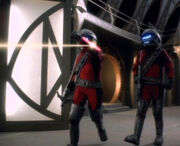
The hand-held variation of the Hunters
In 2369, Starfleet made first contact with a species from the Gamma Quadrant, the Hunters. The first contact ended in a shootout on the Deep Space 9 Promenade in which the Hunters used a hand-held deflector shield, integrated into their uniforms on their left arms. These shields collected the phaser fire and bundled the fire, letting the Hunters take several phaser shots without being hit. (DS9: "Captive Pursuit")
Shield types
- Auto-regenerative shielding
- Covariant shield
- Defense field
- Immersive shielding
- Metaphasic shield
- Metaphysic shield
- Multi-adaptive shield
- Multi-spatial force field
- Multi-spectrum shielding
- Multiphasic shield
- Paratrinic shield
- Refractive shield
- Regenerative shield
- Temporal shield
- Unimatrix shield
- Structural integrity shield
